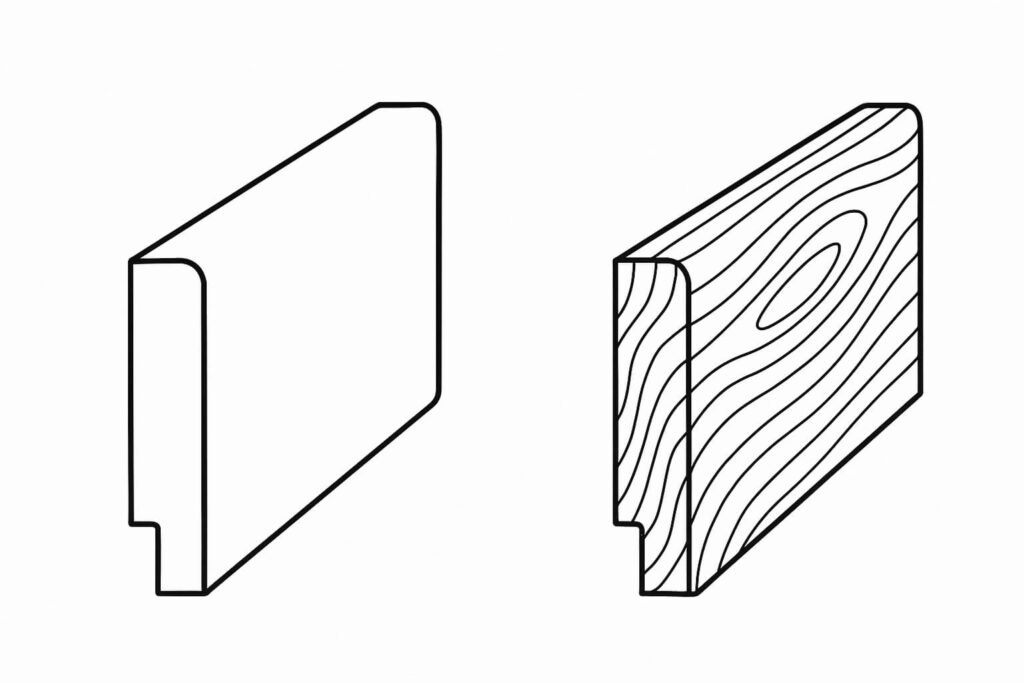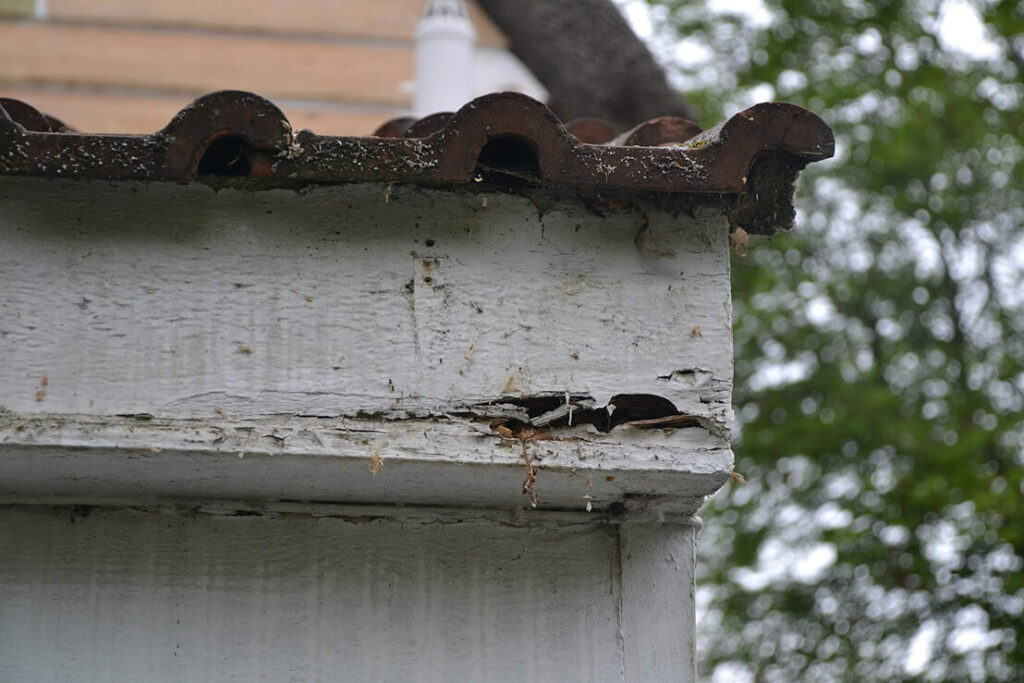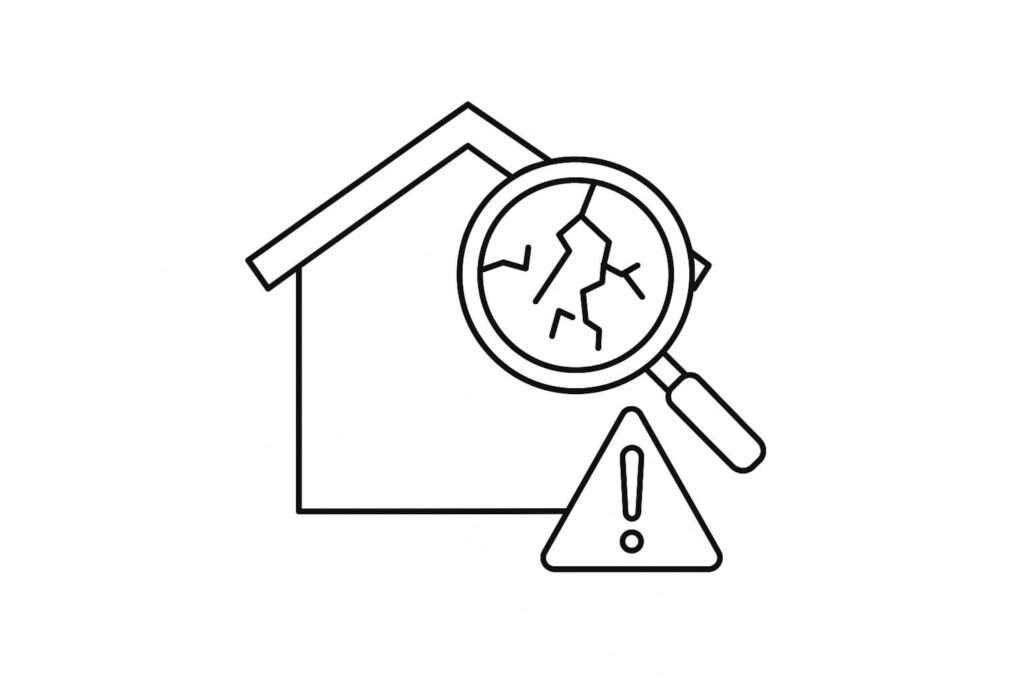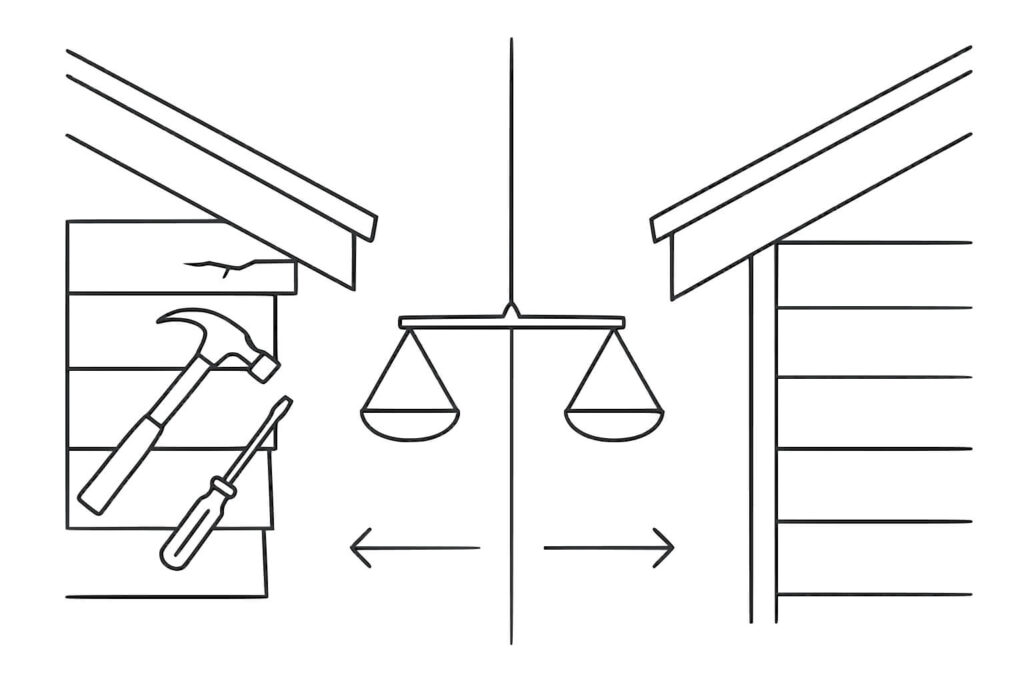UPVC vs Wood Fascias and Soffits: Complete Comparison Guide 2025
Choosing between UPVC and wood fascias and soffits represents one of the most important decisions in roofline renovation, affecting not only immediate costs but also long-term maintenance requirements, aesthetic appeal, and property value. This comprehensive comparison examines all aspects of both materials to help you make an informed decision that aligns with your budget, maintenance preferences, and architectural requirements.
Material Characteristics and Performance
UPVC Material Properties
UPVC (Unplasticized Polyvinyl Chloride) represents modern synthetic technology specifically engineered for exterior building applications. This advanced material combines weather resistance, dimensional stability, and longevity in a low-maintenance package that has revolutionized roofline protection across the UK.
The cellular structure of UPVC provides excellent insulation properties while maintaining structural strength adequate for supporting guttering systems and withstanding wind loads. Modern UPVC formulations include UV stabilizers that prevent color fading and surface degradation, ensuring consistent appearance throughout the material’s 25-30 year service life.
Chemical resistance makes UPVC immune to rot, pest damage, and most environmental contaminants that affect organic materials. This resistance extends to salt air in coastal areas, industrial pollution in urban environments, and agricultural chemicals in rural locations, making UPVC suitable for all UK environmental conditions.
Wood Material Characteristics
Traditional timber fascias and soffits offer natural beauty, workability, and authentic character that complement period architecture and personal aesthetic preferences. High-quality timber properly selected, treated, and maintained can provide decades of reliable service while offering superior repairability compared to synthetic alternatives.
Species selection significantly affects performance, with hardwoods like oak and cedar providing superior durability compared to softwoods like pine and fir. However, even premium hardwoods require regular maintenance to preserve appearance and prevent moisture-related deterioration in exposed roofline applications.
Natural variation in timber creates unique grain patterns and character that cannot be replicated in synthetic materials. This authenticity makes timber the preferred choice for heritage properties, conservation areas, and homeowners who prioritize natural materials despite higher maintenance requirements.
Cost Analysis and Long-term Value
Initial Installation Costs
UPVC systems typically cost £40-65 per linear meter installed, representing moderate initial investment that provides excellent long-term value. Standard profiles and colors offer the most competitive pricing, while premium woodgrain finishes and contemporary colors add 15-25% to material costs.
Timber installation costs range from £50-85 per linear meter depending on species selection and finishing requirements. Hardwood species command premium prices but provide superior longevity, while softwood alternatives offer lower initial costs with reduced service life expectations.
Installation complexity affects costs for both materials, with UPVC requiring specialized cutting and fitting tools while timber demands traditional carpentry skills and finishing expertise. Professional installation is essential for both materials to ensure optimal performance and warranty compliance.
Long-term Cost Comparison
UPVC systems provide superior long-term value through minimal maintenance requirements and extended service life. Over a 25-year period, UPVC typically costs 40-60% less than timber when maintenance, repair, and eventual replacement costs are considered.
Timber maintenance costs include regular painting or staining every 3-5 years at £8-12 per linear meter, plus periodic repairs for rot, pest damage, or weather-related deterioration. These ongoing costs often exceed the initial installation cost over the timber’s service life.
Energy efficiency benefits from proper UPVC installation and ventilation can provide annual savings of £100-200 in heating and cooling costs. These savings contribute to the overall value proposition while improving home comfort and environmental performance.
Property Value Impact
Both materials can enhance property value when properly installed and maintained, but market preferences vary based on property type, location, and buyer demographics. UPVC appeals to buyers seeking low-maintenance solutions, while timber attracts those prioritizing natural materials and traditional aesthetics.
Period properties often benefit more from authentic timber restoration that preserves architectural character and appeals to heritage-conscious buyers. However, well-designed UPVC installations can provide acceptable alternatives that offer superior long-term value without compromising property marketability.
Modern properties typically benefit from UPVC installations that complement contemporary design while providing superior performance and reduced maintenance obligations. These installations often represent selling points for busy homeowners seeking low-maintenance properties.
Maintenance Requirements and Longevity
UPVC Maintenance Needs
UPVC maintenance requirements are minimal, typically limited to annual cleaning with standard household detergents and periodic inspection of fasteners and seals. The non-porous surface resists dirt accumulation and can be easily cleaned without special equipment or materials.
Color stability eliminates repainting requirements throughout the service life, with factory-applied colors integral to the material rather than surface treatments. Even minor surface damage rarely affects appearance or performance, as colors extend throughout the material thickness.
Inspection requirements include annual assessment of fasteners, seals, and ventilation function to ensure continued optimal performance. Professional maintenance services can provide comprehensive inspection and minor adjustments when needed, but most homeowners can perform routine maintenance independently.
Timber Maintenance Demands
Timber maintenance requires regular attention to preserve appearance and prevent deterioration. Painting or staining every 3-5 years is essential for weather protection, with preparation work often requiring significant time and effort to achieve professional results.
Surface preparation for timber maintenance includes cleaning, sanding, filling, and priming that can be labor-intensive and time-consuming. Professional painting services typically cost £8-12 per linear meter but ensure proper preparation and application for optimal longevity.
Ongoing repairs for timber systems include addressing rot, pest damage, warping, and fastener problems that develop over time. These repairs require carpentry skills and may necessitate partial replacement of damaged sections, adding to long-term maintenance costs.
Service Life Expectations
UPVC systems typically provide 25-30 years of reliable service with minimal maintenance, making them excellent long-term investments for most residential applications. Warranty coverage often extends 10-20 years, demonstrating manufacturer confidence in material performance.
Timber service life varies significantly based on species selection, installation quality, maintenance consistency, and environmental exposure. Well-maintained hardwood installations can provide 20-25 years of service, while softwood alternatives may require replacement after 10-15 years.
Environmental factors significantly affect timber longevity, with coastal exposure, urban pollution, and extreme weather accelerating deterioration. UPVC performance remains consistent across all UK environmental conditions, providing predictable service life regardless of location.
Aesthetic Considerations and Design Flexibility
UPVC Appearance Options
Modern UPVC systems offer extensive design flexibility through various profiles, colors, and finishes that complement both traditional and contemporary architecture. Woodgrain finishes provide realistic timber appearance without associated maintenance requirements.
Color options include traditional white, various shades of brown and grey, and contemporary colors that reflect current architectural trends. Factory-applied colors ensure consistent appearance and eliminate the color matching challenges common with painted timber systems.
Profile variety enables architectural coordination with different property styles, from traditional ogee profiles that complement period properties to contemporary square-edge designs that enhance modern architecture. This flexibility makes UPVC suitable for virtually any architectural application.
Timber Aesthetic Advantages
Natural timber provides authentic character and unique grain patterns that cannot be replicated in synthetic materials. This authenticity makes timber the preferred choice for heritage properties, conservation areas, and homeowners who prioritize natural materials.
Customization possibilities with timber are virtually unlimited, including custom profiles, decorative elements, and specialized joinery that can match existing architectural details. This flexibility makes timber essential for authentic restoration of period properties.
Paint and stain options for timber enable unlimited color choices and the ability to change appearance over time. This flexibility allows homeowners to update their property’s appearance without replacing roofline components, though it requires ongoing maintenance commitment.
Architectural Compatibility
UPVC systems work well with most architectural styles when appropriately selected and installed. Modern formulations and profiles can complement both traditional and contemporary properties while providing superior performance and reduced maintenance.
Heritage properties may require careful UPVC selection to ensure compatibility with architectural character and planning requirements. Some conservation areas restrict UPVC use, making timber the only acceptable option for maintaining planning compliance.
Contemporary properties often benefit from UPVC installations that complement modern design principles while providing superior performance. Clean lines, consistent colors, and minimal maintenance requirements align well with contemporary lifestyle preferences.
Environmental Performance and Sustainability
UPVC Environmental Impact
UPVC manufacturing requires significant energy input and produces environmental impacts during production, though modern manufacturing processes have reduced these impacts through improved efficiency and recycling programs. End-of-life recycling capabilities enable material recovery and reuse in new products.
Service life environmental benefits include reduced maintenance chemical use, elimination of paint and solvent requirements, and reduced replacement frequency compared to timber alternatives. These benefits often offset manufacturing impacts over the material’s service life.
Energy efficiency benefits from proper UPVC installation and ventilation reduce heating and cooling energy consumption, providing ongoing environmental benefits throughout the system’s service life. These benefits contribute to reduced carbon footprint and lower utility costs.
Timber Environmental Considerations
Sustainably sourced timber represents a renewable resource with relatively low manufacturing energy requirements and carbon sequestration benefits during tree growth. However, transportation, processing, and treatment chemicals add to environmental impact.
Maintenance environmental impact includes regular use of paints, stains, and solvents that contain volatile organic compounds and require careful disposal. These ongoing environmental impacts accumulate over the timber’s service life.
End-of-life disposal for treated timber may require special handling due to preservative chemicals, while untreated timber can be composted or burned cleanly. However, the shorter service life of timber results in more frequent replacement and associated environmental impacts.
For detailed information about our professional UPVC installation services, visit our UPVC fascias and soffits page which outlines our comprehensive approach to modern roofline solutions.
Decision-Making Framework
Property Type Considerations
Period properties and conservation areas often require timber installations to maintain architectural authenticity and planning compliance. However, carefully selected UPVC systems can provide acceptable alternatives when properly designed and installed.
Modern properties typically benefit from UPVC installations that complement contemporary design while providing superior performance and reduced maintenance. These installations often represent optimal value for busy homeowners seeking low-maintenance solutions.
Commercial properties usually favor UPVC systems for their durability, low maintenance, and consistent appearance that maintains professional image without ongoing maintenance obligations. Cost-effectiveness over the building’s service life makes UPVC attractive for commercial applications.
Lifestyle and Maintenance Preferences
Homeowners who enjoy maintenance activities and prefer natural materials may find timber installations rewarding despite higher ongoing costs and time commitments. The ability to customize appearance and perform repairs can appeal to hands-on property owners.
Busy professionals and those seeking minimal maintenance obligations typically prefer UPVC systems that provide superior performance without ongoing attention. The predictable costs and minimal time requirements make UPVC attractive for modern lifestyles.
Investment property owners usually favor UPVC installations for their reduced maintenance requirements, predictable costs, and tenant appeal. The reduced maintenance obligations and longer service life provide superior investment returns.
Budget and Financial Considerations
Limited budgets may favor UPVC installations for their superior long-term value despite potentially higher initial costs. The reduced maintenance requirements and longer service life provide better total cost of ownership for most applications.
Adequate maintenance budgets can make timber installations viable for homeowners who prioritize natural materials and authentic appearance. However, ongoing costs must be considered in long-term financial planning.
Investment analysis should consider total cost of ownership including initial installation, ongoing maintenance, energy efficiency benefits, and eventual replacement costs. UPVC typically provides superior financial returns over extended periods.
Professional Recommendations
Material Selection Guidance
Professional assessment of your specific requirements, property characteristics, and local conditions enables optimal material selection that balances performance, aesthetics, and budget considerations. Our expertise ensures appropriate recommendations for your unique situation.
Planning compliance and building regulation requirements may influence material selection, particularly for heritage properties or conservation areas. Professional guidance ensures appropriate solutions that meet all regulatory requirements.
Long-term value optimization requires consideration of all factors affecting material performance and costs over the system’s service life. Professional analysis ensures decisions that provide optimal value and satisfaction.
Installation Quality Assurance
Professional installation is essential for both UPVC and timber systems to ensure optimal performance, warranty compliance, and long-term satisfaction. Our certified installers possess expertise with both materials and ensure superior results.
Quality control processes ensure all installations meet manufacturer specifications and industry standards regardless of material selection. Our systematic approach ensures consistent quality and optimal performance for all installations.
Warranty coverage provides protection for materials and workmanship with clear documentation and ongoing support. Our comprehensive warranties demonstrate confidence in our work and provide customer protection.
Contact us today for professional consultation on UPVC vs timber selection for your specific requirements. Our experienced team provides expert guidance and superior installation services that ensure optimal performance and complete satisfaction regardless of material selection.




